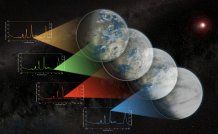articles
articles

Credit: Jay Friedlander and Britt Griswold, NASA GSFC
Quest to uncover intricacies of exoplanet atmospheres reaches important milestone
The quest to uncover intricacies of the atmospheres of faraway planets has reached an important milestone.
An international team, including astrophysicists from the University of Exeter, is taking lessons and techniques learned from Earth climate science to pave the way to robustly model atmospheres of planets orbiting distant stars, aiding in the search for potentially habitable exoplanets.
Crucially, the team believes that this research can also enhance our fundamental understanding and predictions of future climate on Earth.
The recently launched James Webb Space Telescope (JWST) and upcoming telescopes such as the European Extremely Large Telescope (E-ELT), the Thirty Meter Telescope (TMT) or the Giant Magellan Telescope (GMT) may soon be able to characterise the atmospheres of rocky exoplanets orbiting nearby red dwarfs (stars cooler and smaller than our own Sun). However, without robust models to interpret and guide these observations we will not be able to unlock the full potential of these observatories.
One method is to use three-dimensional General Circulation Models (GCMs) — similar to those that are used to predict the Earth’s climate, to simulate atmospheric features as the planets orbit their host stars. However, intrinsic differences exist within these complex GCMs that lead to contrasting climate predictions — and consequently our interpretation of the exoplanet observations.
In recent years, scientists have refined GCMs in an attempt to reproduce and understand the current warming trend associated with anthropogenic climate change on Earth. A key approach is to model climate with multiple GCMs and contrast them via Model Intercomparison Projects, or MIPs, which have been fundamental to our knowledge of the Earth’s climate.
The team, led by three early career researchers — Thomas Fauchez (NASA GSFC, American University, USA), Denis Sergeev (University of Exeter, UK) and Martin Turbet (LMD, France) — has used this expertise and recent model upgrades to undertake a comprehensive intercomparison of several of the world’s leading GCMs applying them to the study of exoplanets.
Dr Sergeev, a postdoctoral researcher at the University of Exeter said: “Multi-model intercomparisons are one of the pillars of modern climate science and a success story of international collaboration. They are instrumental in our understanding of past, present and future climate processes. By bringing these comparisons into exoplanet research, we can ultimately improve our ability to interpret telescope observations.”
The pivotal new project, called THAI (TRAPPIST-1 Habitable Atmosphere Intercomparison) focuses on a confirmed, Earth-sized, exoplanet labelled TRAPPIST-1e. It is the fourth planet from its host star, a red dwarf TRAPPIST-1 located approximately 40 light years from Earth. Crucially, as the planet’s orbit lies within the habitable zone of TRAPPIST-1 it may have a temperate climate suitable for liquid water to exist on its surface.
The projects combines four widely-used models - ExoCAM (based on the model of the US National Centre for Atmospheric Research), LMD-G (developed by the Laboratoire de Meterologie Dynamique in Paris), ROCKE-3D (based on the NASA GISS model) and the UM (developed at the UK Met Office and adapted for exoplanets by researchers at the University of Exeter) - to consider four different scenarios for the atmosphere of TRAPPIST-1e.
These comprised two scenarios for the surface (completely dry, and one covered by a global ocean providing moisture for the atmosphere) and two scenarios for the atmospheric composition (nitrogen-rich atmosphere with modern-Earth levels of CO2, or a Mars-like CO2-dominated atmosphere).
One of the largest sources of inter-GCM differences are clouds: their optical properties, altitude, thickness, coverage have been shown to significantly differ between the models due to differences in cloud parameterizations. “Representing small-scale moist physics in GCMs is notoriously difficult. It is one of the major avenues of atmospheric research for both the exoplanet and Earth climate science,” Dr Sergeev said.
Dr. Fauchez, who leads the THAI project, said: “THAI has leveraged valuable expertise from the similar efforts in the Earth science community studying anthropogenic global warming. However, it has also been able to transfer knowledge back, through improvements in the underlying model frameworks developed as part of the exoplanet applications.”
The results of these analyses, which include showing, for the first time, how the use of a GCM can impact future data interpretation and future planning of observational campaigns, are presented in three fully open-access articles. The full results are published on September 15th 2022 in a special issue of the Planetary Science Journal (PSJ).
However, the team believes that THAI will not only pave the way for robust modelling of potentially habitable distant worlds, but has also connected our efforts to find life beyond Earth with studies of our own changing climate.
Dr Sergeev added: “Our work on TRAPPIST-1e, with a very different orbital configuration to Earth revealed several improvements to, for example, the treatment of the stellar heating of the atmosphere, now implemented in the UM and applied to Earth."
THAI paves the way for a larger model intercomparison project, the Climates Using Interactive Suites of Intercomparisons Nested for Exoplanet Studies (CUISINES) that would include a broader diversity of exoplanet targets and models to systematically compare and therefore validate them.
Full copies of the articles can be found by visiting:
The TRAPPIST-1 Habitable Atmosphere Intercomparison (THAI). I. Dry Cases—The Fellowship of the GCMs: https://iopscience.iop.org/article/10.3847/PSJ/ac6cf0
The TRAPPIST-1 Habitable Atmosphere Intercomparison (THAI). II. Moist Cases—The Two Waterworlds: https://iopscience.iop.org/article/10.3847/PSJ/ac6cf2
The TRAPPIST-1 Habitable Atmosphere Intercomparison (THAI). III. Simulated Observables—the Return of the Spectrum: https://iopscience.iop.org/article/10.3847/PSJ/ac6cf1
Date: 15 September 2022
